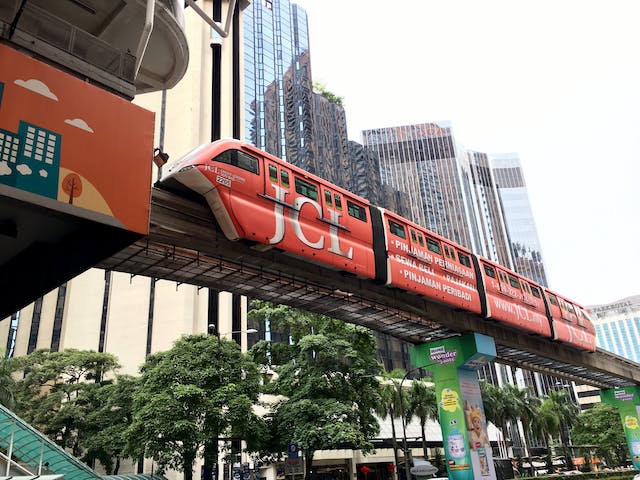
How does a monorail balance? The single rail of a monorail train is much wider than a rail on a regular railway and there is no worry about balancing. However, they use side wheels for support.
There are two types of monorail train. The first type, and probably the most common type, ride on top of the rail. The second type of train are suspended below the rail. According to Wikipedia, there are only 10 operational suspension railways in the world at the moment. There are quite a few used in mines because they are able to climb a much steeper gradient than a train or a regular monorail.
The first monorail was made in 1820 in Russia and it had a train mounted on a wooden beam. The track was built on pillars, but horses pulled the train, so there was a parallel track for the horses as well. There were several different types of monorail built over the next twenty years. One of them did run on a single thin rail and it used a gyroscope to balance. The designer couldn’t get enough interest and he dropped the idea. There were more attempts in the early 20th century, but they never caught on. In the 1960s, monorails were installed in Walt Disney’s parks and that was probably most people’s first experience of them. Today, all Disneylands have a monorail. In the 60s and 70s, some American cities tried to build monorail systems, but they were fought by companies such as Standard Oil and General Motors because they wanted car dependency. The number of monorails has increased in recent years, but there are still not a lot of them. Tokyo probably has the world’s most famous monorail. It runs from Haneda airport into the city and carries 127,000 people every day.
So, how does a monorail balance? The rail a monorail runs on is not thin. The beam is called a straddle-beam and they are usually made of concrete with rails on either side. The train has rubber wheels on its bottom, on the top of the rail. These support the weight of the train and propel it. The train also has wheels on either side of the rail, both at the top and the bottom. These wheels are used for support and balance. They make sure that the train stays on the rail.
Is a monorail better than a regular railway train? Monorails do have some disadvantages, but they also have many benefits over regular trains and subway systems. Monorails are far more efficient than trains because they only have one point of contact with the rail, while a train obviously has two. More points of contact with the rails increases the amount of friction, slowing the train down and increasing its inefficiency. Monorails can also go up greater inclines than trains can because there is more grip between a rubber tire and concrete than there is between a metal wheel and a metal rail. A monorail could climb a 10% incline without any problem.
Monorails are also far easier to build than trains or subway systems. A subway system requires enormous networks of tunnels to be built under a city, which is very expensive. And a rail network needs land to be cleared and hills either moved or tunneled through, which is also expensive. Monorails travel on pillars and raised tracks, so any city planning a monorail only needs to build the track and it can fit into existing architecture. A monorail can also be built artistically and doesn’t have to be an eyesore. The raised track will also give passengers something to look at, which they don’t get in a dark subway tunnel. Another advantage is that a monorail train follows the track and doesn’t need to be steered. For this reason, they can be automated very easily.
There are several disadvantages as well. The stations are difficult to build because they have to be elevated as well. It is also not easy to extend the network. If you want to extend a railway line, you just have to lay more track. A monorail is a little more difficult. Interconnecting track networks are also tricky because for a monorail to switch tracks, the whole track has to be moved, which is more difficult and more time consuming than a railway switching point.
One thing to consider, though, is that maglev trains are also monorails. Maglevs float along the track and have almost no friction, making them incredibly fast. Some countries are considering maglev lines, but they are incredibly expensive to build. However, the technology will get cheaper over time and maglev may be a regular occurrence in the near future. Maglev trains don’t have a problem balancing either. And this is what I learned today.
Photo by Raveender Nagaraju: https://www.pexels.com/photo/monorail-in-kuala-lumpur-13459238/
Source
https://en.wikipedia.org/wiki/Monorail
https://www.monorails.org/tMspages/MonoVs.html
https://link.springer.com/article/10.1007/s40864-015-0006-9
